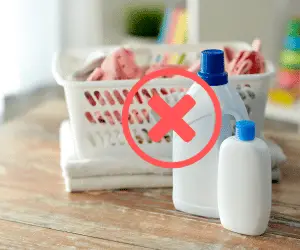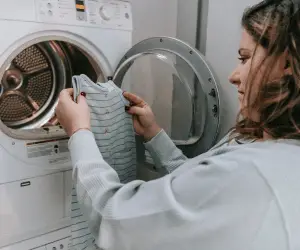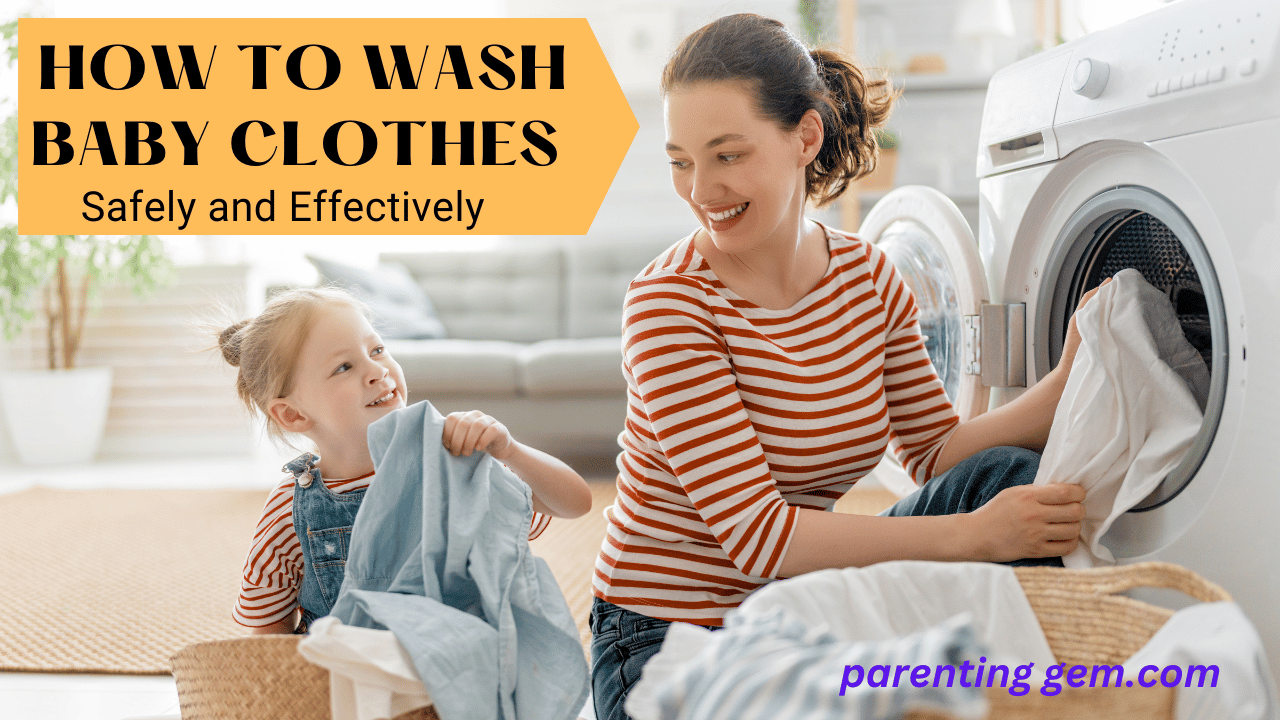As a parent, you want to ensure your children are safe and comfortable. Keeping their clothes clean is no exception! With the delicate nature of baby and children’s clothing, it can often be challenging to figure out how to wash baby clothes effectively.
From avoiding harsh chemicals that could irritate your child’s skin to dealing with stains and washing the items, parents must consider many things when keeping their little ones’ wardrobes in tip-top shape.
We have just what you need if you’re looking for tips on looking after your baby’s clothing naturally and effectively! Read on for our helpful guide on keeping those special garments looking good as new!
Understanding the Basics of Washing Baby Clothes
To begin with, it’s crucial to understand why baby clothes require different treatment from adult clothing. Babies have more sensitive skin than us, which means harsh detergents and certain fabrics can cause irritation and discomfort. Therefore, a mild, fragrance-free detergent is typically advised when washing baby clothes.
Next, pay close attention to the clothing labels. They offer valuable instructions on how to care for the garment properly. The label will tell you the right temperature to wash the clothes at and whether they are suitable for machine wash or require hand washing.
When it comes to stains (and there will be plenty!), it’s best to tackle them immediately. Use a stain remover that is safe for baby clothes, and follow the instructions carefully.
Additionally, baby clothes should always be washed separately from the adult’s laundry. This eliminates the risk of harsh fabric softeners or strong detergents affecting your baby’s wear.
Lastly, washing all new clothes before your baby wears them is good practice. New garments often have a chemical finish that can cause irritation and remove potentially harmful substances from production.
Types of Detergent to Avoid for Baby Clothes

Now that you know the basics of washing baby clothes, let’s take a closer look at the types of detergents you should avoid:
- Optical Brighteners: These synthetic chemicals may give your child’s clothes a deceptive sheen, making the fabric appear whiter and brighter than it truly is. However, they have a downside—they could trigger skin allergies and irritate. Steer clear of any detergent advertising this feature.
- Phosphates: While they might be champions at banishing dirt and grime, phosphates pose a dual threat. On one hand, they have a detrimental impact on the environment, contributing to water pollution. On the other, they could trigger skin irritation in your baby. Therefore, it’s best to opt for phosphate-free options.
- Added Fragrances: The allure of fresh and clean-smelling clothes can be tempting. However, detergents laced with synthetic fragrances can incite allergies, induce asthma, or lead to skin reactions. A safer alternative is to choose detergents void of added fragrance.
To ensure the health and comfort of your precious one, consider hypoallergenic, fragrance-free detergents specially formulated for baby clothes. Also, remember to perform a patch test by washing a small piece of your baby’s clothing with a new detergent before doing a full load. This precautionary step can help determine if the detergent suits your baby’s skin. Always prioritize your baby’s safety when choosing products for their clothing care.
Ways to Remove Stains from Baby Clothes
Babies are adorable, but they sure know how to make a mess. Whether you’re dealing with food stains, spit-ups, or diaper disasters, removing stains from baby clothes is an art every parent needs to master. Here are some strategies you can employ:
- Pre-Treat Stains: For stubborn stains, pre-treatment is critical. Apply a stain remover to the stain. Try to do this as soon as possible to prevent the stain from setting in. Let the remover sit on the stain for a few minutes before washing.
- Soak in Cold Water: Soak the stained garment for 30 minutes after pre-treatment. Cold water helps to lift the stain so it can be more easily removed during washing. Don’t use hot water because it can cause protein-based stains like milk or blood.
- Use Baby-Safe Stain Removers: Not all stain removers suit baby clothes. Some contain harsh chemicals that can irritate sensitive baby skin. Always choose baby-safe, hypoallergenic stain removers. Remember to read the labels and follow instructions on these products.
- Wash the Clothes: After pre-treatment and soaking, wash the clothes as usual. If the stain is still visible after washing, redo the process. Avoid drying the clothes until the stain is gone, as heat can set it, making it harder to remove.
- Sun-Drying: The sun’s ultraviolet rays are a natural bleaching agent. After washing and while the garment is still damp, hang it in the sun. This method can help to lighten any remaining discoloration from the stain.
Remember, patience is vital when removing stains from baby clothes. Some stains may require multiple treatments to disappear completely. Try to stay on top of stains by treating and washing them as soon as they occur. Your little one’s wardrobe will thank you!
The Benefits of Pre-treating Stains on Baby Clothes

As we’ve previously discussed, pre-treating stains on baby clothes is a crucial step in maintaining the pristine condition of your little one’s wardrobe. This practice not only eases the laundering process but also increases the longevity of the garments. Pre-treatment is especially effective in dealing with stubborn stains that can be challenging to remove during a regular wash cycle.
Applying a baby-safe stain remover directly to the stain before washing essentially targets the stain at its source. This allows the remover to penetrate the fabric and break down the stain at a molecular level, making it easier to wash away. This is particularly useful for protein-based stains—such as those caused by food or spit-ups—which can be particularly tenacious.
Bear in mind our previous caution regarding selecting a suitable stain remover. Opt for those explicitly formulated for baby clothes, as they are free from harsh chemicals that could irritate your child’s sensitive skin. Also, remember the importance of performing a patch test to ensure the product’s suitability.
Interestingly, pre-treatment also offers environmental benefits. You can get great results by targeting stains directly, even with a lower washing temperature. This not only saves energy but also helps to preserve the color and fabric quality of the clothes.
Pre-treatment of stains is a beneficial practice that every parent should adopt. Not only does it ensure clean, fresh clothes for your baby, but it also contributes to a sustainable and environmentally friendly laundry routine. So, next time you’re faced with a baby-related stain disaster, remember to pre-treat!
Best Way to Wash Baby Clothes In a Washing Machine

When it comes to washing baby clothes in a washing machine, you want to ensure that the process is effective in retaining their softness and color while guaranteeing a high level of hygiene:
- Separation is essential: Always remember to wash your baby’s clothes separately from the rest of your laundry. This will help avoid any cross-contamination.
- Choose the Right Detergent: A gentle, baby-safe laundry detergent is crucial. This safeguards your little one’s delicate skin from irritants.
- Loading the Machine: Avoid overcrowding when putting clothes in the washing machine. This ensures effective cleaning and proper rinsing.
- Setting the Machine: Opt for a gentle wash cycle and use cold water. This helps prevent shrinkage and color bleeding.
- Unloading: As soon as the wash cycle finishes, promptly remove the clothes. This helps to prevent wrinkles and mildew formation.
- Drying: According to Consumer Reports, air-drying baby clothes, especially those made of natural fibers, is the best practice. However, if you’re using a dryer, set it in a low-heat setting.
Following these steps ensures that your baby’s clothes are clean, safe, and well cared for. An essential aspect of this process is the temperature at which you wash these delicate garments. So, let’s delve into the optimal washing temperature for baby clothes.
What Temperature Should I Use When Washing Baby Clothes?
Choosing the correct washing temperature for baby clothes is fundamental to ensuring their longevity and cleanliness. Here’s a detailed guide to help you make the right choice:
- Cold Wash (30°C or 86°F): A cold wash is ideal for light colors, delicate fabrics, and clothes with minor stains. It’s also great for protecting the bright colors of your baby’s clothes from fading.
- Warm Wash (40°C or 104°F): This temperature is recommended for general, sturdy fabrics and moderate to heavy soil. However, it can cause some shrinkage and color bleeding in certain fabrics.
- Hot Wash (60°C or 140°F): Hot Wash is ideal for sanitizing baby clothes, especially during illness or if the garment is soiled. However, it’s unsuitable for delicate fabrics as it can cause shrinkage.
- Boil Wash (100°C or 212°F): Boil wash is rarely used for baby clothes. It’s reserved for durable fabrics and is usually unnecessary for most baby items.
Always make sure to read the garment’s care label before deciding on the washing temperature. Also, consider using a laundry sanitizer in a cold wash to ensure a high level of hygiene without using high temperatures. Your baby’s clothes need special care, and understanding washing temperatures is a step in the right direction.
Should You Line-Dry or Tumble-Dry Baby Clothes?
Deciding whether to line-dry or tumble-dry baby clothes is integral to the laundry process. Both methods have pros and cons, and your chosen method can depend on various factors, such as the type of fabric, weather conditions, and personal preference.
Line-drying is an eco-friendly option that uses no energy other than the sun and wind. It can be gentle on baby clothes, maintaining their shape and size better than tumble-drying. Also, the sunlight can help brighten whites and kill bacteria. However, line-drying can be time-consuming and requires good weather conditions.
On the other hand, tumble-drying is fast and convenient. It can be beneficial when there are other options than line-drying in cold or humid weather. Tumble-drying can also make clothes feel softer, which can be excellent for baby clothes. But, it can cause shrinking, fading, and wear-and-tear over time.
According to the American Cleaning Institute, it’s best to tumble-dry baby clothes in a low-heat setting to minimize potential damage. Some baby clothes, especially those made of synthetic materials, should not be dried using high heat.
Always check the care labels on each garment to decide the best drying method for your baby’s clothes. These labels provide specific instructions about washing, drying, and ironing tailored to the fabric and construction of the garment. Adhering to these instructions can help ensure that your baby’s clothes remain in good condition and last longer.
Remember, the goal is to maintain the quality and hygiene of your baby’s clothes while minimizing potential skin irritants. Whether you choose to line-dry or tumble-dry, the most important thing is handling your baby’s clothes carefully.
Common Mistakes Parents Make When Washing Baby Clothes
Ensuring our baby’s clothes are clean and safe is paramount as parents. However, some common mistakes can occur in the process, compromising these garments’ quality, longevity, and safety. Here are a few significant missteps to avoid:
- Ignoring Care Labels: The care labels on baby clothes provide important instructions on washing, drying, and ironing. These guidelines are specifically tailored to the fabric and construction of the garment. Ignoring these can lead to damage, such as shrinkage, color bleeding, and fabric weakening.
- Using Standard Detergents: Regular detergents can be harsh on a baby’s delicate skin, causing irritation and rashes. Using a baby-safe or sensitive skin detergent can help prevent this.
- Overloading the Washing Machine: Overcrowding the washing machine can lead to inadequate cleaning and rinsing of clothes. It’s best to wash smaller loads to ensure a thorough clean.
- Not Pre-Treating Stains: Baby clothes are prone to get messy. Pre-treating stains before washing can significantly improve the chances of completely removing the stain.
- Not Washing New Clothes: New clothes can have residual chemicals from manufacturing. Washing them before the first wear helps remove these residues.
- Incorrect Drying Methods: Each fabric type requires a different drying method. While some clothes are best air-dried, others can handle tumble-drying. Wrong drying methods can cause shrinkage, fading, and wear and tear.
By avoiding these typical errors, you may be sure of your baby’s clothes’ cleanliness, safety, and durability. Remember, the goal is to keep your baby’s clothes in the best condition while ensuring they are safe and comfortable for your little one.
Conclusion

In conclusion, taking proper care of your baby’s clothes is essential to being a parent. It’s important to avoid using certain types of detergent, use effective stain removers, pre-treat if needed, and properly wash and dry your baby’s garments to keep them looking new.
While some parents might feel overwhelmed by the process, following these care instructions for laundering your baby’s clothes will ensure they last and look great as long as possible. Also, remember to check labels on baby clothing for specific washing instructions, and always refer back to this blog post for easy guidelines you can follow!
If you have further questions, please comment below and tell us your thoughts. If there are any other topics you would like us to explore, Together, we can all learn more about taking the correct steps to keep our little ones looking their best!
FAQ
Deciding whether to line-dry or tumble-dry baby clothes is integral to the laundry process. Both methods have pros and cons, and your chosen method can depend on various factors, such as the type of fabric, weather conditions, and personal preference.

